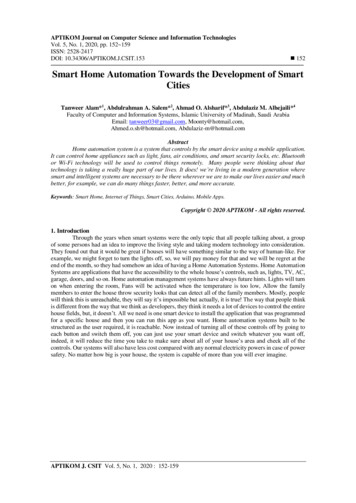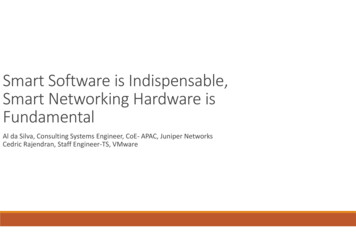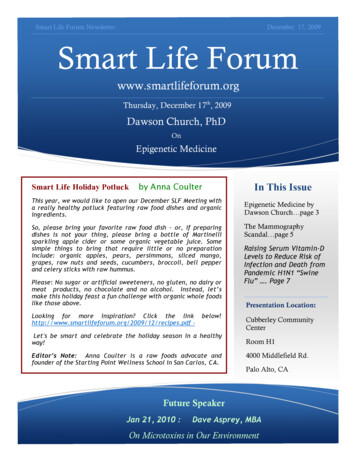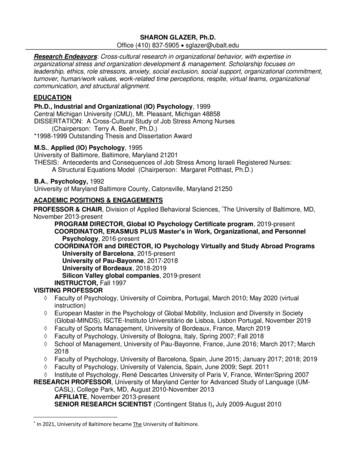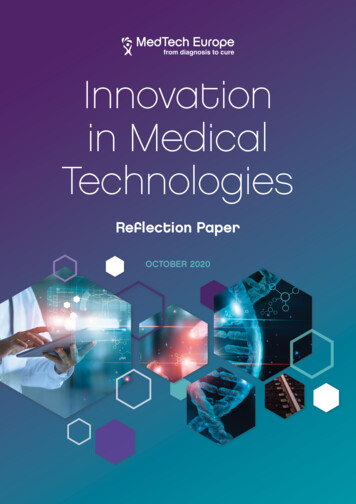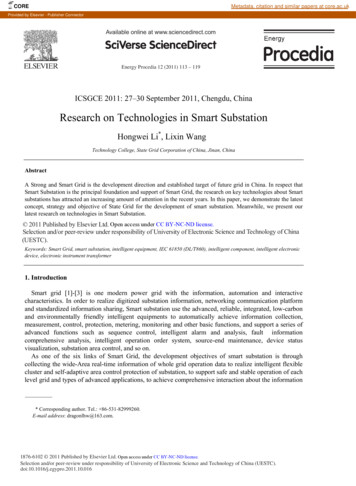
Transcription
COREMetadata, citation and similar papers at core.ac.ukProvided by Elsevier - Publisher ConnectorAvailable online at www.sciencedirect.comEnergyProcediaEnergy Procedia(2011) 000–000Energy00Procedia12 (2011) 113 – 119www.elsevier.com/locate/procediaICSGCE 2011: 27–30 September 2011, Chengdu, ChinaResearch on Technologies in Smart SubstationHongwei Li*, Lixin WangTechnology College, State Grid Corporation of China, Jinan, ChinaAbstractA Strong and Smart Grid is the development direction and established target of future grid in China. In respect thatSmart Substation is the principal foundation and support of Smart Grid, the research on key technologies about Smartsubstations has attracted an increasing amount of attention in the recent years. In this paper, we demonstrate the latestconcept, strategy and objective of State Grid for the development of smart substation. Meanwhile, we present ourlatest research on technologies in Smart Substation. 2011 Published by Elsevier Ltd. Open access under CC BY-NC-ND license.Selection and/or peer-review under responsibility of University of Electronic Science and Technology of China(UESTC).Keywords: Smart Grid, smart substation, intelligent equipment, IEC 61850 (DL/T860), intelligent component, intelligent electronicdevice, electronic instrument transformer1. IntroductionSmart grid [1]-[3] is one modern power grid with the information, automation and interactivecharacteristics. In order to realize digitized substation information, networking communication platformand standardized information sharing, Smart substation use the advanced, reliable, integrated, low-carbonand environmentally friendly intelligent equipments to automatically achieve information collection,measurement, control, protection, metering, monitoring and other basic functions, and support a series ofadvanced functions such as sequence control, intelligent alarm and analysis, fault informationcomprehensive analysis, intelligent operation order system, source-end maintenance, device statusvisualization, substation area control, and so on.As one of the six links of Smart Grid, the development objectives of smart substation is throughcollecting the wide-Area real-time information of whole grid operation data to realize intelligent flexiblecluster and self-adaptive area control protection of substation, to support safe and stable operation of eachlevel grid and types of advanced applications, to achieve comprehensive interaction about the information* Corresponding author. Tel.: 86-531-82999260.E-mail address: dragonlhw@163.com.1876-6102 2011 Published by Elsevier Ltd. Open access under CC BY-NC-ND license.Selection and/or peer-review under responsibility of University of Electronic Science and Technology of China (UESTC).doi:10.1016/j.egypro.2011.10.016
2114HongweiLiLietandWang/ Energy00Procedia12 (2011) 113 – 119Hongweial. Lixin/ EnergyProcedia(2011) 000–000and strategies of equipment operation and maintenance with electric dispatch, to realize optimalmanagement of life-cycle equipment based on condition monitoring; the smart and integration aregradually realized for main substation equipments; digitized substation information, networkingcommunication platform, standardized information sharing, interactive advanced application, efficientoperation and maintenance provide a solid foundation for the strong and smart grid.Compared with traditional substations, smart substations [4]-[6] achieve the intelligent management ofsubstation equipments by advanced data analysis processing methods based on advanced sensortechnologies. The integration of primary and secondary equipments is realized through intelligentlyreforming traditional primary equipments with electronic instrument transformers and condition-basedmonitoring technologies. Key equipments such as transformers and switches with intelligencecomponents are to achieve the integration of condition-based monitoring, measurement, protection,control and other functions. IEC 61850 (DL/T860) provide a unified information model and interfacestandard for substation automation system. Based on the unified standard, advanced applications formanagement and control units of substation can be realized by integrating and reusing substationinformation. Through intelligently reforming the auxiliary system, non-electric profession such as patternrecognition, machine learning, image and video processing etc. can improve the intelligent levels ofsubstations, and enhance the security, stability and reliability of substation operation.The organization of the paper is as follows: Section II describes technologies for intelligent primaryequipments. Section III demonstrates technologies for integrative secondary system. Section IV discussesthe development of advanced applications. Finally, Section V summarizes the contributions of this paper.2. Intelligent Primary EquipmentThe intelligence of primary equipments [7] is to namely realize digital measurement, networkingcontrol, status visualization, function integration, information interaction of high voltage equipments. Keytechnologies include advanced sensor technology, condition-based monitoring technology and intelligentcomponent technology. Through inside or outside monitoring sensors, the condition-based monitoringtechnologies can achieve the condition monitoring and visualization of important primary equipments,such as transformers, switchgears, lightning arresters, etc.At the recent stage, the realization of intelligent primary equipments should suitably adopt thefollowing manner: “primary equipment sensors intelligent components”. Intelligent components areflexible configuration of the intelligent electronic devices (IED), which include smart terminal, mergingunit, condition-based monitoring IED and so on. In the future, the development of intelligent primaryequipment is the integration as one single device.2.1. Intelligent transformerThe intelligence of transformers [1], [7] can be realized by additionally installing state variable sensorsand intelligent components. Intelligent transformers would have perception capability through monitoringstate variables of transformer, shown in Fig. 1. Sensor S1 and S2 measure the top oil temperature oftransformer, S3 and S4 for the bottom oil temperature; Sensor S5, S6, S9 and S10 measure voltage andcurrent signals; Sensor S7 and S8 on-line monitor the information of partial discharge; Sensor S12 is oilchromatogram monitor which analyses the composition and content of gases dissolved in transformer oil;Sensor S13, the micro-water monitor, measure the water content in transformer oil. Through analyzingthe information of partial discharge, oil chromatogram and micro-water, we can real-time monitor theinsulation status of transformer and further achieve types and reasons of insulation failure.
HongweiLi and/ EnergyProcedia12 (2011)113 – 119HongweiLiLixinet al.Wang/ EnergyProcedia00 (2011)000–000Fig. 1. Schematic diagram of intelligent transformer.Local-installed intelligent components have measure- ment, control, condition-based monitoring, nonelectrical protection and other functions. Simultaneously transmitting related information to integrativeinformation platform based on IEC 61850 (DL/T860) standard, intelligent transformers will be realized indigital measurement, intelligent control, status visualization and information interaction.2.2. Intelligent gas insulated switchgearThe intelligence of Gas Insulated Switchgear (GIS) [7] can be realized by additionally installing statevariable sensors and intelligent components.Intelligent GIS not only realizes the monitoring and control of substation operation, but also realizesthe collection and processing of GIS status information. In the intelligent control area, switchingequipments in GIS achieve the “one-button sequence control” function. Application of intelligentcomponents reflects the functional integration and local installation of technological trends.In intelligent GIS, local-installed intelligent components transmit monitoring information to integrativeinformation platform based on IEC 61850 (DL/T860) standard, and realize the visualization of statusanalysis results. Table 1 shows the list of intelligent items recently used in GIS.Table 1. The list of intelligent items in mentand controlMeteringIntelligent FunctionMechanical characteristicsBreakerMechanism statusPartial dischargeMicro-waterInsulating gas densityLightning arrester monitoringRedundancy configuration of bayprotection [8]Integrative functionElectric meter functionIEDBreaker monitoring IEDPartial discharge IEDGas monitoring IEDLightning arrester monitoring IEDIntegrative Device with protect, control measurement , andmetering function3115
4116HongweiLiLietandWang/ Energy00Procedia12 (2011) 113 – 119Hongweial. Lixin/ EnergyProcedia(2011) 000–0002.3. Electronic Instrument TransformerCompared with electromagnetic instrument transformer, the advantages of electronic instrumenttransformer [9] include small size, strong anti-saturation capability, good linearity, etc. Electronicinstrument transformers can avoid inherent problems such as ferroresonance, insulating oil explosion, SF6leaks, and have better economical efficiency in high voltage level through saving a lot of iron core,copper and other metal materials. Table 2 shows comparison results of several instrument transformers.Table 2. Comparison results of several instrument transformersElectric instrument ic HybridOpticalmagnetooptical glassfiber opticalPrincipleEM inductionEM inductionFaraday EffectFaraday EffectSensorEM coilAir-core coiloptical glassfiberDigital OutputNoYesYesYesSaturationYesNoNoNoMeasuring rangeSmallMediumLargeLargefrequency bandnarrowMediumBroadBroadDegree of technical ecurityBadGoodGoodGoodRequirements to merging unitNowhateverYesYes2.4. Existing ProblemsAt the recent stage, intelligent primary equipments involve with in the integration of multipletechnologies, which including monitoring, protection, measurement, control and metering, especiallysensor technology. The integration of multiple technologies [10] leads to the stability and reliabilityproblems of equipments. Due to sensor’s life shorter than the primary equipment’s, we should furtherconsider and research the effects of sensors embedded in devices, the performance stability, samplingaccuracy and single function of sensors in the future.Recently, the stability and reliability of electronic instrument transformers [11] should be furtherimproved and enhanced. These problems involve with the stability of the internal integrator, electromagnetic interference (EMI), ground shield, temperature, vibration and other interference factors.3. Integrative Secondary SystemIEC 61850 (DL/T860) is one of key technologies and main standard for smart substation construction,which provides implementation scheme of information model, information description, network structureand data interaction. Based on IEC 61850, smart substation achieves the “ One World, One Standard”goal, unifies the communication interface for all substation devices, and realizes the interoperability andextendibility between equipments reserving interface for distributed energy source’s access. IEC 61850defines the basic three-layer architecture of integrative secondary system in smart substation. Three-layerconsists of station layer, bay layer and process layer.
HongweiLi and/ EnergyProcedia12 (2011)113 – 119HongweiLiLixinet al. Wang/ EnergyProcedia00 (2011)000–000The architecture of three-layer tow-network is shown in Fig. 2. Two-network includes and processlayer network. Station layer network use the communication protocol based on manufacturing messagespecification (EMS) between station layer and bay layer. Process layer network is composed of genericobject oriented substation event (GOOSE) network and sample value (SV) network. The advantage of thisarchitecture furthest meets the information sharing leading to flexible function distribution and consumesfewer fibers. The disadvantage of this architecture is that due to protection depending on networkswitches and GPS, the failure of a single device could cause a wide range of protection fault.Fig. 3 shows the architecture of three-layer one-network. One-network means the integration of MMS,GOOSE, SV and IEEE1588. This architecture doesn’t require process layer switches, and can’t increasethe range of station layer, and then has the characteristic of simplest network structure and minimuminvestment.Fig. 2. The architecture of three-layer tow-network.Fig. 3. The architecture of three-layer one-network.GOOSE networking model is the future development direction of smart substation, which can greatlyreduce the number of fibers used in substation, but also provide the convenience for construction,debugging, operation and upgrading maintenance of smart substation.5117
6118HongweiLiLietandWang/ Energy00Procedia12 (2011) 113 – 119Hongweial. Lixin/ EnergyProcedia(2011) 000–0004. Advanced ApplicationsAs an important component of smart grid, the advanced applications can realize sequence control,intelligent alarm and analysis, comprehensive fault analysis, condition-based maintenance, source-endmaintenance and other advanced functions, which make smart substation achieving collaborative control,comprehensive analysis, and efficient operation and maintenance capabilities.4.1. Integrative Information PlatformBased on unified modeling ideas and methods of IEC 61850(DL/T860), integrative informationplatform directly samples various data of supervisory control and data acquisition (SCADA), protection,fault recorder and condition-based monitoring from station layer network. In ensuring the integrity andconsistency of basic data, integrative information platform constructs one unified panorama databa
2.2. Intelligent gas insulated switchgear The intelligence ofGas Insulated Switchgear (GIS)[7] can be realized by additionally installing state variable sensors and intelligent components. Intelligent GIS not only realizes the monitoring and controlof substation operation, but also realizes the collection and processingof GIS status information. In the intelligent controlarea, switching



